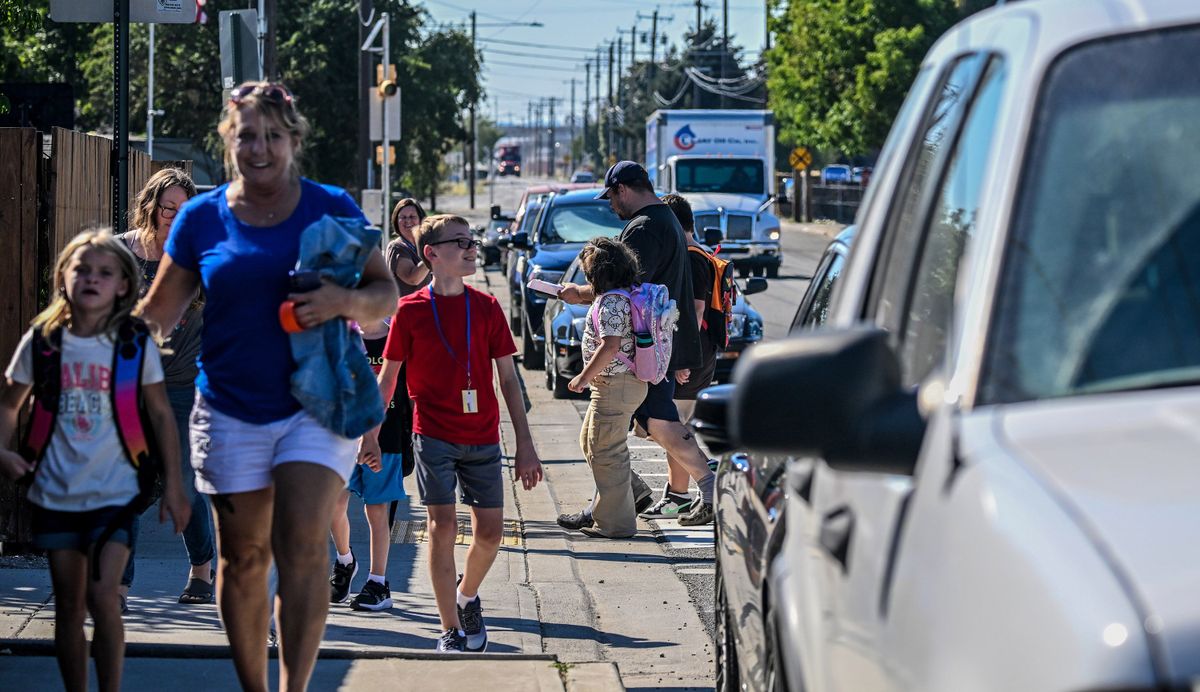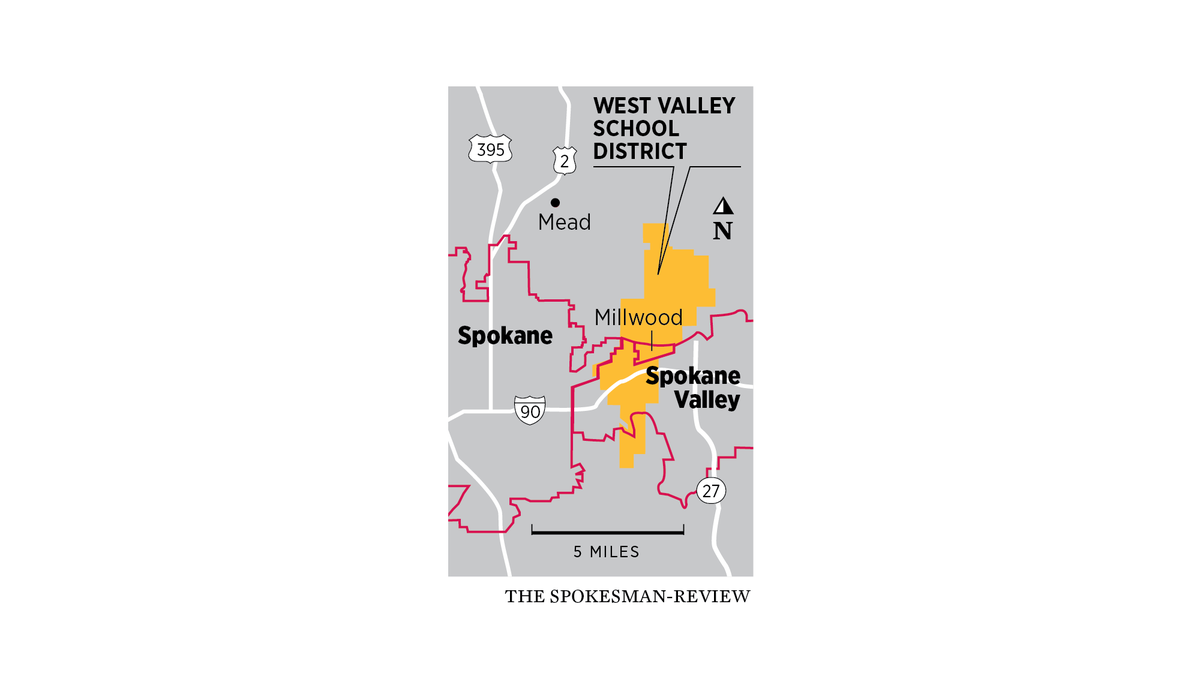West Valley School District seeks levy to improve parent pickup, other construction projects in the wake of February bond failure
Students and parents make their way through lines of traffic during pick-up time Sept. 4 at Seth Woodard Elementary School. (Kathy Plonka/The Spokesman-Review)
After casting a vote for president, governor, and state schools superintendent, voters in the West Valley School District will also be asked if they support a property tax levy to pay for remodeling and repairing school buildings.
The levy would collect $11.8 million over three years, taxing voters at an estimated rate of $1 per $1,000 in assessed property value. This levy would replace the existing capital levy that will collect at a rate of $1.26 in 2024. With these taxes, the district would pay to modernize entrance security, finish repairing the roof at West Valley High School and updating pickup and drop-off areas at two elementary schools.
If passed, the levy renewal would bring West Valley property owners’ tax bill for local schools to an estimated rate of $3.44 per thousand, 6 cents cheaper than tax collection rates this year for local schools.
The district repaired half of the roof on West Valley High School last summer, and now the district seeks funds to finish the job. Seth Woodard and Orchard Center elementary schools have safety concerns in their parent pickup and drop-off areas, said Superintendent Kyle Rydell, and those would be addressed with tax collections under the replacement levy. They’re also seeking to update heating and cooling needs at the soon-to-be Millwood early learning center, which last year housed kindergarteners.
The district has been successful in passing capital levies every three years for more than 20 years.
“It’s been one of those pieces that has helped support our district around technology, safety and just the whole piece of keeping our buildings operational from a maintenance standpoint,” Rydell said.
Among intended project lists, the district hopes to redesign the parent pickup/drop-off systems at Seth Woodard and Orchard Center to make them safer and more efficient, Rydell said.
Johnathan Curley
At Seth Woodard Elementary School, 117 parents pick their students from a school that currently has no designated parent drop-off/pick-up zone. Parents form a line dozens of cars deep on Mission Avenue outside their school, stretching around the corner onto Park Road. Some congregate in the neighborhood across the street, others borrow parking to the ire of nearby businesses.
Some parents wait up to an hour for their student’s dismissal, arriving early to secure a spot near their school.
“It does get pretty congested, it makes me kind of nervous especially with this crosswalk here,” said parent Mykayla Kline, picking up her second grader from their first day of school on Wednesday. She arrived at 2:30 p.m. for her child’s 3:15 dismissal.
“But I always try to be the early bird,” she said.
A crossing guard from the school stands at the crosswalk across Mission Avenue, holding a neon orange flag and guiding youngsters and their parents across the two-lane stretch.
Kline said while she appreciates the crossing guard, she’d feel safer with flashing lights at the crosswalk.
Though the posted speed limit is 20 mph as school lets out, some drivers exceed this limit, others make U-turns in the street while kids and teachers walk the adjacent sidewalk.
“There’s a lot of congestion in the area,” said intervention specialist Gina Behrens. “Lots of industrial trucks going through, semis, traffic off of I-90, pedestrians and people not paying attention to the speed limit can be kind of confusing.”
“We have a lot of kids who don’t always think before they act,” Behrens said. “So it requires a lot of adult supervision to make it run smoothly.”
A designated area off the main street would improve the safety for students and efficiency for drivers caught in the congestion of parents retrieving their kids, some parents said.
Ken Maidhoff, parent of four who attended Seth Woodard, has adapted to the situation in his 18 years picking up his kids. He parks in the same spot at the edge of the parking lot each year, though not in a designated spot.
“I don’t mind how they do it today,” Maidhoff said. “But I wouldn’t mind a drive-up either.”
Ideally, he said Seth Woodard’s pick-up zone would mirror that at Pasadena Park Elementary. The other West Valley school has a larger parking lot with a designated loop for parent pick-up.
The district hoped to pass a bond in February to fund five major projects around the district. In February, the $92 million package failed to garner the supermajority support needed to authorize the district to borrow money for this construction.
West Valley’s bond represented a countywide phenomenon: none of the five bond-seeking districts had success.
In the wake of this failure, each school district sought a different approach to address these needs. Cheney Public Schools and Deer Park School District decided to try again to pass a bond, adding them to ballots in November. Spokane Public Schools and Riverside School District are holding off on presenting voters with another tax proposal for the time being.
West Valley, which serves 3,400 students in Millwood, parts of Spokane Valley and north of the Valley, is unique this November. They’re hoping to address some of the projects that would have been funded through the bond with capital levy tax collections and return to voters years down the line with another, possibly cheaper, bond ask.
“Our board really stepped back and said, ‘Hey, let’s create this three-year replacement cycle. Let’s address some major needs in the district for the next three years, and then maybe circle back on that conversation around, is it time for a bond?’,” Rydell said.
West Valley administrators are breaking their district’s cycle of seeking a bond every 20 years to pay for school construction. Compared to a bond, a levy taxes property owners for a shorter period – three years to the bond’s 20. A levy collects less in taxes.
Under the proposed levy, property owners would pay a total estimated rate of $3.44 per thousand when accounting for the educational programs and operations levy passed in February.
Rydell said in addressing some of the facility expenses through this capital levy, they’re able to return to voters with a cheaper bond later down the line.
“Hopefully, fast forward to 2027 and our bond could look considerably different because we were able to tackle some of these smaller projects to create a little less of a tax burden on our community over those 20 years,” Rydell said.

